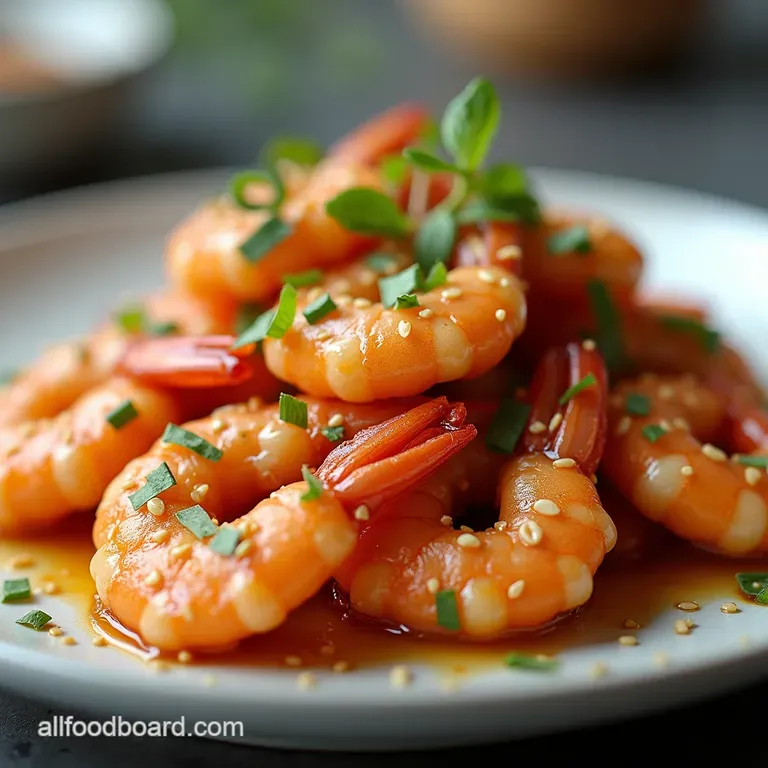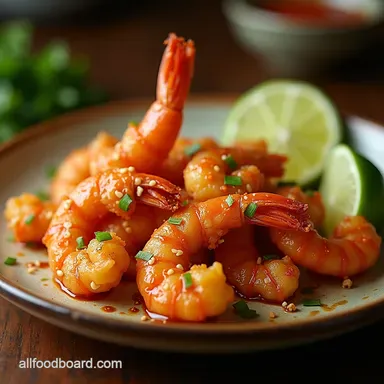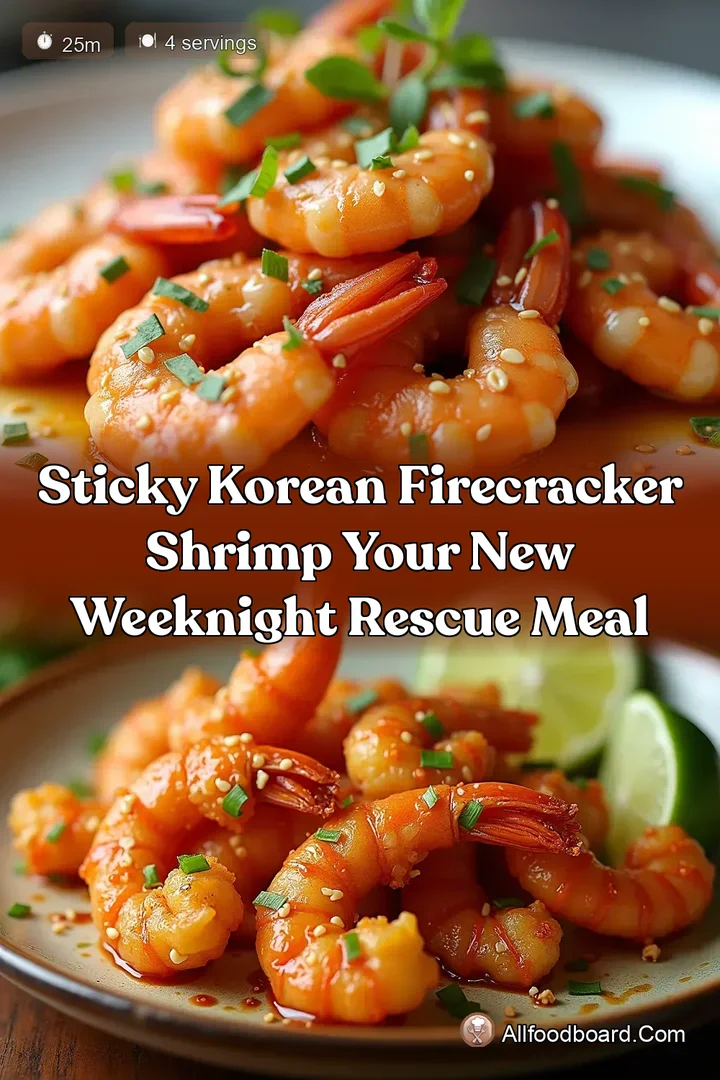Sticky Korean Firecracker Shrimp with Sesame Lime

- Igniting Your Weeknight: Why This Gochujang Shrimp Recipe Sizzles
- The Anatomy of Flavour: Sweet Heat Meets Deep Umami
- Assembling the Essential Toolkit for Phenomenal Shrimp
- The Gochujang Glaze Components: Balancing Fire and Honey
- The Step-by-Step Journey to Perfectly Caramelised Gochujang Shrimp
- Achieving Maximum Sizzle: Cooking Techniques Explained
- Maximising Your Leftovers and Customising the Heat Level
- Recipe FAQs
Sticky Gochujang Shrimp

Ingredients:
Instructions:
Nutrition Facts
Igniting Your Weeknight: Why This Gochujang Shrimp Recipe Sizzles
When the mid-week slump hits, the last thing you want is another predictable plate of protein and steamed vegetables. You crave flavour—deep, complex, and slightly addictive. That’s precisely what our Gochujang Shrimp delivers. This dish isn't just another way to cook seafood; it’s an infusion of Korean culinary vibrancy that transforms simple prawns into a show-stopping meal in under 30 minutes. Forget complicated fermentation processes; we are harnessing the power of accessible, flavour-packed ingredients to create something truly memorable. If you’re searching for exciting shrimp recipes for dinner , prepare to bookmark this one, because its sticky, sweet, and spicy glaze is utterly unforgettable.
The Anatomy of Flavour: Sweet Heat Meets Deep Umami
The true genius of Korean cooking lies in layering contrasting elements until they achieve perfect harmony. Our recipe for Sticky Korean Firecracker Shrimp takes inspiration from this philosophy, focusing on creating a glaze that sings on the palate. It’s a symphony where the fermented depth of gochujang anchors the dish, while bright acidity and profound sweetness lift every bite. This approach elevates the humble prawn into something spectacular, perfect for a quick yet satisfying seafood dinner .
Ditching Dinner Dullness: A Korean-Inspired Culinary Upgrade
We all have those weeknight meals we default to when time is short. This Gochujang Shrimp Recipe is designed to replace those defaults. It requires minimal hands-on time—only about 15 minutes of prep—but yields results that taste like they simmered for hours. The core of this upgrade is the balance achieved in the glaze, which coats the protein beautifully, turning a simple sear into a masterpiece of texture and taste.
What Makes This Gochujang Shrimp Unforgettable
What sets this dish apart from standard sweet and sour preparations is the distinct funk and slow-building heat provided by the gochujang itself. When combined with Mirin (for sweetness and shine) and a touch of rice vinegar (for necessary tang), the resulting coating is rich, sticky, and wonderfully glossy. Whether you plan to serve it over rice as a complete Gochujang Shrimp Bowl or mix it into Gochujang Shrimp Noodles , the flavour profile remains the undeniable hero.
Prep Time Secrets: Speeding Towards Success
With a goal of having this meal on the table in roughly 25 minutes total, efficiency is key. The 15 minutes of prep time are dedicated to three essential tasks: properly drying the large shrimp (a crucial step for texture!), quickly whisking together the seven components of the glaze, and mincing your aromatics. Keeping these small preparatory steps grouped together ensures that the actual cooking time is a rapid, exhilarating 8 to 10 minutes of high-heat action.
Assembling the Essential Toolkit for Phenomenal Shrimp
To achieve that coveted, perfectly crisp exterior that holds onto the sticky sauce, your approach to the shrimp itself needs to be precise. We are using large shrimp, typically a 21/25 count, which offer a satisfying bite. A light dusting of cornstarch is non-negotiable; it acts as a protective shield during the searing process, ensuring the surface crisps up nicely before the glaze is introduced. Work in batches if needed to avoid overcrowding the pan, which would cause the shrimp to steam rather than brown.
Related Recipes Worth Trying
- Zesty LemonChili Shrimp Quinoa Bowls Quick Healthy — Whip up these Zesty LemonChili Shrimp Quinoa Bowls in minutes Packed with flavor and goodforyou ingredients Get the recipe now
- Grilled Cajun Creole Shrimp with Sausage Bayou Bliss — Fancy some proper tasty Grilled Cajun Creole Shrimp with Sausage These Bayou Bliss Skewers are zesty spicy and grilled to perfection A little taste of New...
- Korean BBQ Steak Rice Bowls My Gochujang Cream Secret — OMG these Korean BBQ Steak Rice Bowls are epic Tender steak spicy Gochujang cream proper flavour bomb Ready in 45 mins Get the recipe
The Gochujang Glaze Components: Balancing Fire and Honey

The magic truly happens when we combine the sauce ingredients. This sticky, flavour-packed coating is what defines this dish, transforming simple prawn dishes into something explosively good. The base relies on a strategic partnership between heat, depth, and sweetness.
Selecting the Perfect Protein: Shrimp Size and Preparation
We insist on using large shrimp (about 1.5 lbs or 680g for four servings). Once peeled and deveined, the most critical preparatory step is thorough drying. Take your time patting them absolutely bone-dry with paper towels. This dryness allows the cornstarch to adhere evenly and ensures a superior sear when they hit the hot oil, preventing them from becoming rubbery.
The Sauce Foundation: Beyond Just Chilli Paste
The heart of our Gochujang Shrimp Marinade (though we are technically glazing, the principles of flavour saturation apply!) is, of course, the chilli paste. We balance 3 tablespoons of Gochujang with 2 tablespoons of low-sodium soy sauce for savoury depth, 2 tablespoons of sweet Mirin for that signature Japanese-Korean sheen, and 1 tablespoon of honey or maple syrup to temper the heat. A quick teaspoon of rice vinegar injects a necessary acidic counterpoint, making the whole flavour profile pop.
Essential Pantry Items for Roasting and Finishing Touches
While the glaze is primary, the supporting cast of aromatics makes all the difference. You will need a generous amount of fresh garlic (about 4 cloves, minced) and freshly grated ginger (1 teaspoon). These are quickly sautéed to release their fragrant oils before the sauce goes in. Finally, the dish finishes off-heat with a drizzle of toasted sesame oil and a generous squeeze of fresh lime juice—these final additions provide aromatic warmth and brightness that cuts through the richness of the glaze.
The Step-by-Step Journey to Perfectly Caramelised Gochujang Shrimp
The process is beautifully straightforward, moving rapidly from raw ingredient to glazed delight. First, the shrimp are coated in cornstarch and quickly seared in neutral oil until just opaque. They are then removed. Next, the pan’s residual heat is used to bloom the minced garlic and ginger for mere seconds until fragrant. This is the moment you pour in your whisked Gochujang sauce mixture. Allow it to bubble and thicken for just about a minute. Finally, the seared shrimp return to the pan, tossed swiftly to ensure every piece is cloaked in that sticky, sweet and spicy shrimp coating before you pull it immediately from the heat for the final flavour boosts.
Achieving Maximum Sizzle: Cooking Techniques Explained
Cooking these fiery prawns correctly hinges on managing heat and timing. Since shrimp are delicate, the speed at which you cook them directly correlates with their final texture.
Marination Magic: Letting the Flavours Intertwine
For this specific recipe, we skip a long, overnight marinade. Instead, the cornstarch application serves to prepare the shrimp for the quick sear. The real flavour infusion happens in the final moments when the shrimp are tossed directly into the thickened, simmering glaze, allowing the sauce to adhere instantly without dissolving the texture of the protein.
The Sheet Pan Strategy: Ensuring Even Cooking and Crisping
While some might opt for a sheet pan approach, we find the stovetop method superior for achieving that intense, sticky caramelisation that defines this dish. A heavy-bottomed skillet or wok allows for high, direct heat transfer, which is essential for getting the cornstarch crust onto the shrimp quickly and efficiently.
Glaze Application Timing for Sticky Perfection
Timing is everything when adding the sauce back to the shrimp. Once the sauce has visibly thickened (it should coat the back of a spoon easily), the shrimp must go back in and be tossed for no more than 30–45 seconds. Any longer, and the heat trapped in the pan will overcook the shrimp, resulting in a tough texture rather than a tender one.
Presentation Pointers: Garnishing Your Fiery Feast
The visual appeal of this Gochujang Shrimp Stir Fry is nearly as important as the taste. Once plated, immediately scatter a generous pinch of toasted sesame seeds over the top for texture and nutty aroma, followed by thinly sliced green parts of scallions. The vibrant green against the deep, lacquered red-orange glaze is striking.
Maximising Your Leftovers and Customising the Heat Level
One of the joys of this recipe is its versatility, both in how you serve it and how you can adjust the spice level to your preference.
Storing and Reheating Your Sticky Shrimp
Leftovers store beautifully in an airtight container in the refrigerator for up to three days. When reheating, aim for speed. A quick toss in a hot, dry non-stick skillet over medium-high heat for 1 to 2 minutes is ideal; this re-crisps the outside slightly and reactivates the glaze. Avoid the microwave, as it tends to steam the shrimp and dull the texture.
Variations on a Theme: Exploring Pork and Chicken Alternatives
Should you tire of seafood, this incredible glaze translates beautifully to other proteins. Try using bite-sized pieces of pork tenderloin or boneless, skinless chicken thighs. For these denser meats, you will need to adjust the cooking time; the meat should be seared until nearly cooked through before removing it, and then added back to the simmering sauce earlier to ensure it finishes cooking completely inside the glaze.
Nutritional Snapshot: Lightening Up This Delicious Dish
While the glaze includes honey and Mirin, the overall dish remains relatively light when balanced correctly. With roughly 30g of protein per serving and minimal added fat (from the cooking oil), it sits well within a balanced meal plan. To keep calories down, simply reduce the amount of honey used in the sauce slightly, and ensure you serve it over cauliflower rice instead of traditional white rice to maximize the benefits of this delicious seafood dinner .
Troubleshooting Common Recipe Pitfalls
If your shrimp turned out rubbery, you likely cooked them too long or didn't pat them dry enough initially, leading to steaming. If your sauce separated or remained thin, you didn't let the mixture simmer long enough in Step 5 before adding the shrimp back; the cornstarch needs that heat to activate and thicken properly. A little extra lime juice at the end always helps revive a sauce that tastes flat or overly sweet.

Recipe FAQs
Can I make this Gochujang Shrimp recipe milder if I don't like too much heat?
Absolutely! Gochujang itself provides both heat and deep flavour, so you can certainly dial it back. Try reducing the Gochujang amount by half and substituting the missing volume with an equal amount of tomato purée or sweet paprika mixed with a tiny dash of Sriracha. You'll retain the colour and depth without setting off the smoke alarm!
My shrimp turned out a bit rubbery; what did I do wrong in the cooking process?
That's a common kitchen woe, but thankfully easy to fix next time! Shrimp cook incredibly fast, usually in just 3-4 minutes total. The key is to sear them quickly until opaque, remove them from the pan while cooking the sauce, and only return them for the final 30 seconds to coat. High heat and speed are your friends here, much like poaching a perfect egg.
What’s the best way to store leftovers of this sticky Gochujang Shrimp?
Treat leftovers like you would any saucy stir-fry; store them in an airtight container in the fridge for up to three days. When reheating, use a low-to-medium heat on the hob or microwave, adding a tiny splash of water or stock to loosen the sauce, as it tends to thicken considerably overnight.
I don't have Mirin; what can I use instead in the sauce?
Mirin lends sweetness and a lovely sheen to the final glaze, but you don't need to panic if the cupboard is bare. You can substitute it with a dry white wine mixed with half a teaspoon of sugar, or, if you want to keep it alcohol-free, use a bit more honey/maple syrup cut with a splash of water to thin it slightly.
Can I use pre-cooked shrimp for this recipe, or do I need raw ones?
It’s best to use raw, peeled, and deveined shrimp for this dish. Pre-cooked shrimp will quickly turn tough and chewy when you try to sear and coat them in the hot sauce. If you only have pre-cooked shrimp, simply warm the sauce through separately and gently toss the cooked shrimp in it right at the very end, turning the heat off immediately.